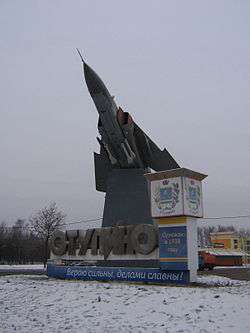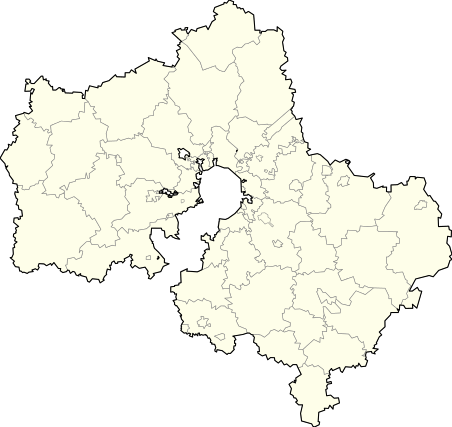Stupino, Stupinsky District, Moscow Oblast
| Stupino (English) Ступино (Russian) | |
|---|---|
| - Town[1] - | |
 A monument at the entrance to Stupino | |
.svg.png) Location of Moscow Oblast in Russia | |
 Stupino | |
|
| |
.png) |
|
|
| |
| Administrative status (as of August 2014) | |
| Country | Russia |
| Federal subject | Moscow Oblast[1] |
| Administrative district | Stupinsky District[1] |
| Town | Stupino[1] |
| Administrative center of | Stupinsky District,[1] Town of Solnechnogorsk[1] |
| Municipal status (as of April 2011) | |
| Municipal district | Stupinsky Municipal District[2] |
| Urban settlement | Stupino Urban Settlement[2] |
| Administrative center of | Stupinsky Municipal District,[2] Stupino Urban Settlement[2] |
| Head | Pavel Chelpan |
| Statistics | |
| Population (2010 Census) | 66,816 inhabitants[3] |
| - Rank in 2010 | 232nd |
| Time zone | MSK (UTC+03:00)[4] |
| First mentioned | 1507 |
| Town status since | 1938 |
| Previous names | Elektrovoz (until 1938) |
| Postal code(s)[5] | 142800, 142802–142806, 142808 |
| Dialing code(s) | +7 49664 |
|
| |
| Stupino on Wikimedia Commons | |
Stupino (Russian: Сту́пино) is a town and the administrative center of Stupinsky District in Moscow Oblast, Russia, located on the Oka River, 99 kilometers (62 mi) south of Moscow. Population: 66,816 (2010 Census);[3] 63,124 (2002 Census);[6] 74,476 (1989 Census).[7]
History
The settlement of Stupino was first mentioned in 1507. Almost all other villages which have been merged into modern Stupino have been known since at least the beginning of the 16th century and were mainly founded on monastery lands. In 1934, Stupino was merged with the work settlement of Elektrovoz. In 1938, Elektrovoz was granted town status and renamed Stupino.
The history of the town is closely linked with the history of the Stupino Metallurgical Company (now known as CMK), which became the town's main industrial enterprise sustaining much of the population. In October 1941, during World War II, the factory was evacuated to Kuybyshev and Kamensk-Uralsky. In February 1942, the factory was returned to Stupino and quickly resumed operation.[8]
After the war, Stupino remained partially closed. Almost all the town's buildings were on the CMK's balance sheet and the company was reporting direct to the Ministry of Defense. In 1957, Sputnik 1, the first Earth satellite, was built with aluminum produced by the CMK.[9]
After the dissolution of the Soviet Union, the town attracted foreign investors, who built several new factories.
Administrative and municipal status
Within the framework of administrative divisions, Stupino serves as the administrative center of Stupinsky District.[1] As an administrative division, it is, together with forty-four rural localities, incorporated within Stupinsky District as the Town of Stupino.[1] As a municipal division, the Town of Stupino is incorporated within Stupinsky Municipal District as Stupino Urban Settlement.[2]
As a result of the election September 14, 2014 the mayor is Pavel Chelpan, unchanged the incumbent for 25 years.
Economy
During the Cold War, the main industry in Stupino was arms production, and it was home of the Stupino Airfield. Since 1995, the town hosts the largest branch factory of Mars, Inc. in Russia. In the recent years, several other foreign companies opened factories in Stupino and its vicinity, including Campina, Kimberly Clark, Kerama Marazzi, Knauf Insulation, and others.
Religion

The town is home to the Belopesotsky Monastery, which contains structures from the 17th century and later.
Twin towns and sister cities
References
Notes
- 1 2 3 4 5 6 7 8 Resolution #123-PG
- 1 2 3 4 5 Law #68/2005-OZ
- 1 2 Russian Federal State Statistics Service (2011). "Всероссийская перепись населения 2010 года. Том 1" [2010 All-Russian Population Census, vol. 1]. Всероссийская перепись населения 2010 года (2010 All-Russia Population Census) (in Russian). Federal State Statistics Service. Retrieved June 29, 2012.
- ↑ Правительство Российской Федерации. Федеральный закон №107-ФЗ от 3 июня 2011 г. «Об исчислении времени», в ред. Федерального закона №271-ФЗ от 03 июля 2016 г. «О внесении изменений в Федеральный закон "Об исчислении времени"». Вступил в силу по истечении шестидесяти дней после дня официального опубликования (6 августа 2011 г.). Опубликован: "Российская газета", №120, 6 июня 2011 г. (Government of the Russian Federation. Federal Law #107-FZ of June 31, 2011 On Calculating Time, as amended by the Federal Law #271-FZ of July 03, 2016 On Amending Federal Law "On Calculating Time". Effective as of after sixty days following the day of the official publication.).
- ↑ Почта России. Информационно-вычислительный центр ОАСУ РПО. (Russian Post). Поиск объектов почтовой связи (Postal Objects Search) (Russian)
- ↑ Russian Federal State Statistics Service (May 21, 2004). "Численность населения России, субъектов Российской Федерации в составе федеральных округов, районов, городских поселений, сельских населённых пунктов – районных центров и сельских населённых пунктов с населением 3 тысячи и более человек" [Population of Russia, Its Federal Districts, Federal Subjects, Districts, Urban Localities, Rural Localities—Administrative Centers, and Rural Localities with Population of Over 3,000] (XLS). Всероссийская перепись населения 2002 года [All-Russia Population Census of 2002] (in Russian). Retrieved August 9, 2014.
- ↑ Demoscope Weekly (1989). "Всесоюзная перепись населения 1989 г. Численность наличного населения союзных и автономных республик, автономных областей и округов, краёв, областей, районов, городских поселений и сёл-райцентров" [All Union Population Census of 1989: Present Population of Union and Autonomous Republics, Autonomous Oblasts and Okrugs, Krais, Oblasts, Districts, Urban Settlements, and Villages Serving as District Administrative Centers]. Всесоюзная перепись населения 1989 года [All-Union Population Census of 1989] (in Russian). Институт демографии Национального исследовательского университета: Высшая школа экономики [Institute of Demography at the National Research University: Higher School of Economics]. Retrieved August 9, 2014.
- ↑ Official website of CMK. СMK. History. 1941-1945
- ↑ Official website of CMK. СMK. History. 1951-1960
Sources
- Губернатор Московской области. Постановление №123-ПГ от 28 сентября 2010 г. «Об учётных данных административно-территориальных и территориальных единиц Московской области», в ред. Постановления №252-ПГ от 26 июня 2015 г. «О внесении изменения в учётные данные административно-территориальных и территориальных единиц Московской области». Опубликован: "Информационный вестник Правительства МО", №10, 30 октября 2010 г. (Governor of Moscow Oblast. Resolution #123-PG of September 28, 2010 On the Inventory Data of the Administrative-Territorial and Territorial Units of Moscow Oblast, as amended by the Resolution #252-PG of June 26, 2015 On Amending the Inventory Data of the Administrative-Territorial and Territorial Units of Moscow Oblast. ).
- Московская областная Дума. Закон №68/2005-ОЗ от 28 февраля 2005 г. «О статусе и границах Ступинского муниципального района и вновь образованных в его составе муниципальных образований», в ред. Закона №57/2011-ОЗ от 22 апреля 2011 г. «О внесении изменений в Закон Московской области "О статусе и границах Ступинского муниципального района и вновь образованных в его составе муниципальных образований" и Закон Московской области "О статусе и границах Чеховского муниципального района и вновь образованных в его составе муниципальных образований"». Вступил в силу со дня официального опубликования. Опубликован: "Ежедневные Новости. Подмосковье", №42, 10 марта 2005 г. (Moscow Oblast Duma. Law #68/2005-OZ of February 28, 2005 On the Status and the Borders of Stupinsky Municipal District and the Newly Established Municipal Formations Comprising It, as amended by the Law #57/2011-OZ of April 22, 2011 On Amending the Law of Moscow Oblast "On the Status and the Borders of Stupinsky Municipal District and the Newly Established Municipal Formations Comprising It" and the Law of Moscow Oblast "On the Status and the Borders of Chekhovsky Municipal District and the Newly Established Municipal Formations Comprising It". Effective as of the day of the official publication.).